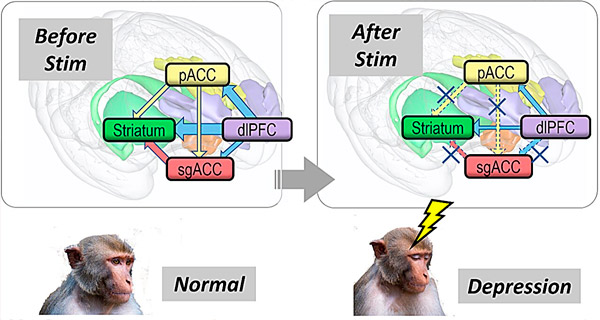Nye publikasjoner
Nedstrøms signaler i hjernekretser som regulerer depresjon oppdaget
Sist anmeldt: 02.07.2025

Alt iLive-innhold blir gjennomgått med medisin eller faktisk kontrollert for å sikre så mye faktuell nøyaktighet som mulig.
Vi har strenge retningslinjer for innkjøp og kun kobling til anerkjente medieområder, akademiske forskningsinstitusjoner og, når det er mulig, medisinsk peer-evaluerte studier. Merk at tallene i parenteser ([1], [2], etc.) er klikkbare koblinger til disse studiene.
Hvis du føler at noe av innholdet vårt er unøyaktig, utdatert eller ellers tvilsomt, velg det og trykk Ctrl + Enter.

Å forstå og behandle depresjon, en potensielt svekkende psykisk helsetilstand som rammer millioner av mennesker over hele verden, er fortsatt en prioritet blant nevrovitenskapelige forskere. Alvorlig depressiv lidelse (MDD) rammer for eksempel omtrent 33 millioner mennesker, eller omtrent 5 % av verdens voksne befolkning.
Emosjonsregulering er en viktig hjernefunksjon som bidrar til å undertrykke følelser og depresjon, og antas å være en beskyttende mekanisme ved alvorlig depresjon. Imidlertid er de nevrobiologiske mekanismene som ligger til grunn for hvordan hjernen regulerer depresjon fortsatt uklare.
For å utforske dette problemet undersøkte en nylig studie ledet av Satoko Amemori og Ken-ichi Amemori, publisert i tidsskriftet Nature Communications, hvordan spesifikke hjernekretser regulerer emosjonelle responser, noe som ga ny innsikt i det nevrale grunnlaget for depresjon.
I denne studien fokuserte forskerne på den dorsolaterale prefrontale cortex (dlPFC), som lenge har vært kjent for å spille en rolle i emosjonsregulering. Forskerne undersøkte hvordan dlPFC-signalet endres ved depresjon og belyste mekanismen som dlPFC regulerer det cingulostriatale nettverket med.
Å avdekke de nevrale mekanismene som ligger til grunn for depressiv atferd hos primater kan legge grunnlaget for å utvikle nye terapeutiske tilnærminger som retter seg mot spesifikke hjernekretser.
Studien undersøkte den såkalte «top-down-påvirkningen» av dlPFC på det cingulostriatale nettverket, som er assosiert med depresjon, i sammenheng med emosjonsregulering. Forskerne undersøkte også hvordan disse kretsene påvirker beslutningstaking og emosjonelle responser.
Ved hjelp av mikrostimuleringsteknikker modifiserte forskerne nevral aktivitet i den subgenuale fremre cingulære cortex (sgACC) hos rhesusaper (Macaca mulatta) og var i stand til eksperimentelt å indusere pessimistisk beslutningstaking og depressive tilstander.
Under disse stimuleringseksperimentene registrerte forskerne også lokale feltpotensialer (LFP-er) for å analysere top-down-påvirkningen av dlPFC på det cingulostriatale nettverket.
De fant at eksperimentelt indusert pessimistisk beslutningstaking ble ledsaget av redusert top-down dlPFC-input til cingulostriatale regioner.
Dette funnet tyder på at forstyrrelse av ovenfra-og-ned-signalet fra kognisjon til følelser kan føre til pessimistisk beslutningstaking, noe som er et karakteristisk trekk ved MDD.
Et av hovedfunnene i studien var rollen til beta-oscillasjoner i frontostriatale kretser. Beta-oscillasjoner har lenge vært assosiert med motorisk kontroll og oppmerksomhet, og i den senere tid har de også blitt knyttet til kognitive funksjoner som arbeidshukommelse.
I denne nye studien reduserte effektiv mikrostimulering av sgACC, som induserer en depressiv tilstand, størrelsen på beta-oscillasjoner som koder for positive variabler relatert til beslutningstaking.

Stim: mikrostimulering, dlPFC: dorsolateral prefrontal cortex, pACC: pregenual anterior cingulate cortex, sgACC: subgenual anterior cingulate cortex.
Kilde: Nature Communications (2024). DOI: 10.1038/s41467-024-48375-1
Denne reduksjonen i beta-oscillasjoner er viktig fordi den antyder en sammenheng mellom sgACC-aktivitet og negativitetsskjevhet i beslutningstaking, noe som gir en potensiell mekanisme for hvordan hjernen behandler positive og negative verdier.
Studien undersøkte også interaksjoner mellom regioner innenfor det fronto-cingulostriatale nettverket. Ved å undersøke faktorer som koherens og Granger-kausalitet (en statistisk test for å avgjøre om en variabel meningsfullt kan beskrives som en avhengig variabel), fant forskerne at effektiv mikrostimulering av sgACC endret disse interaksjonene, noe som gjenspeiler nettverkets involvering i beslutningstaking.
De fant at dlPFCs "top-down-påvirkning" på det cingulostriatale nettverket ble kodet av LFP beta-oscillasjoner, og redusert top-down-påvirkning var assosiert med eksperimentelt indusert depresjon.
Disse funnene fremhever den viktige rollen dette nettverket spiller i emosjonsregulering og beslutningstaking, og hvordan dets dysfunksjon kan føre til depressiv atferd.
Denne studien gir verdifull innsikt i det nevrale grunnlaget for depresjon, og fremhever rollen til spesifikke hjernekretser i reguleringen av emosjonelle responser. Viktigere er det at studien skapte en primatmodell for depresjon og viste at fronto-cingulo-striatale kretser er involvert i reguleringen av det limbiske systemet via beta-oscillasjoner.
Det er viktig å merke seg at forskerne var i stand til å demonstrere at aper viser depressiv atferd i fravær av denne reguleringen. Ved å avdekke mekanismene bak depressiv atferd hos primater, åpner denne studien nye veier for å utvikle mer effektive behandlinger for alvorlig depressiv lidelse.
